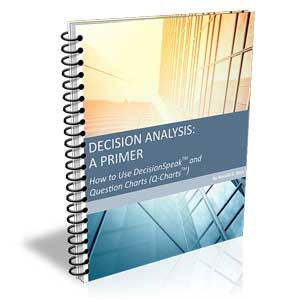Business Decisions, Business Rules, and Business Processes: Oh My!
In this article I summarize my contribution to the panel on Business Decisions at the 2013 Building Business Capability conference. (See [1], [2], and [3] for the other contributors.)
Every few years another concept emerges that raises the hope of analysts and architects that a new solution to all our challenges has arrived. The current buzz is around Business Decisions, but I feel we have to put it all in context. I always caution my clients that if anyone claims that one thing is everything and will solve all problems, you must run away. Hopefully, as architects and analysts, we have learned by now that to build anything (a house or a business) many interconnected parts are needed and multiple professions are required for integrity in design and operation.
When it comes to the subject of Business Decisions, the same is true. They are a great new addition to our ability to design great and adaptable businesses. However, they need business processes to have context and relevance to business outcomes. They also need business rules to have a connection to strategy, policy, and business risk. All three should work together.
Every business must have a commonly-understood reason for its existence, must strive to satisfy its range of external stakeholders despite their potential conflicting requirements, and should do the right work in the right way to support its intentions. Making the right decisions at the right time and place is in the heart of this mix, but the criteria for such decisions need clear motivation and shared criteria for repeatability and scalability purposes.
There are many stakeholders of our businesses; four of the central ones are customers, owners, staff, and regulators.
Customers have a strong interest in the approvals they request from companies or government, some of which may enable or constrain their ability to move on with potentially life-changing actions. These may be very emotional times or even embarrassing for the customer. The decisions we make are very important to them. If you have ever been turned down for a mortgage and cannot buy your dream home, you will understand the criticality of decisions for customers.
Owners are keenly interested in operational and management decisions that impact cost, risk, revenue, and resource allocation.
Staff members want to do a good job and do not want to be un-communicative. They want appropriate empowerment, to be clear on the constraints, and to know the criteria that guides their work, much of which involves making decisions or at the very least explaining them in light of the customer scenario.
Depending on the nature of the business, regulators can be instrumental as the source of decision criteria / rules that inform or define the decisions that staff or software make on behalf of management. They can also shut us down if we are non-compliant.
Our stakeholders are intimately associated with the decisions made within our business processes. Their needs and expectations must be understood and balanced to optimize the business' performance.
The decisions we make change the state of many aspects of the business and drive different process paths, and may invoke additional decisions and rules. They change the state of relationships — for the better or worse. They update the status of instances of products and services provided to customers — from scheduled to shipped. They can change the state of business resources — from available to occupied.
Understanding them is critical to the business processes that call upon the rules that guide the automated or human decisions to be made. The organization's business processes must be evaluated in terms of the strategic intent of the business and the stakeholder needs and expectations against which we will be judged. The decisions made in these processes can make or break the business performance objectives we strive to meet, depending on their quality.
As a matter of fact, many of our processes today exist purely to arrive at a decision. Applying for a loan has one of two possible outcomes: you are approved or you are not. The process and the decision share the same outcome. Many processes can follow a number of different paths each of which are determined by decisions along the way within the process. An existing customer may skip large parts of an ordering process. Business processes are not only about physical transformation of materials or of information, but even if they are, there are many decisions based on business rules that must be made in the progress of an end to end process as it progresses.
In any event, the rules and decision criteria must be known in advance and consistently applied to assure that the performance of the process is reliable and delivers the right outcomes of value to our process stakeholders. The needs and expectations of our stakeholders will vary over time, and the strategy of our organizations will evolve. Smart processes are those that are designed so that the decisions are clearly identified in the right places in the business processes along the way.
Often the actual decision needed to be made will not change a lot over time. Deciding on the credit worthiness of a customer placing an order will be needed regardless of product or service changes. Over time the rules may change, the thresholds may move but the fundamental nature of the process may be stable and the decisions may be the same regardless. Smart processes separate rules from workflow and call on them just-in-time as needed. They externalize rules and reference data to enable flexible changes to decision criteria in response to business changes — or to enable process innovation.
A little guidance for architects, analysts, and designers is to not miss decisions as a key architectural concept. Separate them and align / cross reference decisions to other architectural elements, especially the processes that use them. In doing so, link Business Rules to Business Decisions in Business Processes, not directly to Capabilities, such as technology. Also, do not miss the critical role of business processes since that is where decisions are made, and it is the processes that deliver outcomes to stakeholders and are traceable to strategic performance.
That's the way I see it.
References
[1] Ronald G. Ross, "Three Major Myths of the Business Decision Space — And Why They Matter to Business Analysts," Business Rules Journal, Vol. 15, No. 1 (Jan. 2014), URL: BRCommunity.com/a2014/b737.html ![]()
[2] James Taylor, "Putting Decisions First — Why Building Decision Models Delivers Business Rules Success," Business Rules Journal, Vol. 15, No. 2 (Feb. 2014), URL: BRCommunity.com/a2014/b746.html ![]()
[3] Jan Vanthienen, "Observations on Business Rules, Decisions, and Processes," Business Rules Journal, Vol. 14, No. 3
(Mar. 2014), URL: BRCommunity.com/a2014/b749.html ![]()
# # #
About our Contributor:
Online Interactive Training Series
In response to a great many requests, Business Rule Solutions now offers at-a-distance learning options. No travel, no backlogs, no hassles. Same great instructors, but with schedules, content and pricing designed to meet the special needs of busy professionals.












How to Define Business Terms in Plain English: A Primer
How to Use DecisionSpeak™ and Question Charts (Q-Charts™)
Decision Tables - A Primer: How to Use TableSpeak™
Tabulation of Lists in RuleSpeak®: A Primer - Using "The Following" Clause
Business Agility Manifesto
Business Rules Manifesto
Business Motivation Model
Decision Vocabulary
[Download]
[Download]
Semantics of Business Vocabulary and Business Rules